CMS-PTM
Case Studies / Sample Problems
The following tutorials may be helpful for learning to use CMS-PTM in SMS:
Applying Particle Tracking Model for a Sediment Placement Pilot Study
Introduction
The CMS is an integrated wave, current, sediment transport, and morphology change model for coastal and inlet applications (Buttolph et al. 2006; Lin et al. 2008) that was developed by the Coastal Inlets Research Program (CIRP). The Particle Tracking Model (PTM) was developed jointly by CIRP and the Dredging Operations and Engineering Research (DOER) program as a tool to compute the fate and pathways of sediments and other waterborne particulates in coastal engineering and dredging operations (MacDonald et al. 2006; Demirbilek et al. 2008). CMS-PTM is implemented in the SMS (Aquaveo 2010), which is a graphical user interface utility for PCs as developed by the U.S. Army Corps of Engineers (USACE).
Noyo Nearshore Sediment Placement Pilot Study
Noyo Harbor and Noyo River are located on the northern California coast. Every year about 30,000-40,000 cy of beach-quality sediment is dredged from the Noyo River Federal Navigation Channel. The USACE San Francisco District (SPN) and the Coastal and Hydraulics Laboratory (CHL), U.S. Army Engineer Research and Development Center are presently collaborating with the Noyo Harbor District and stakeholders in a pilot study to investigate a potential candidate site for nearshore placement of dredged sediment. Upland disposal sites used in the past will soon be exceeded. The pilot study proposes a dispersive nearshore site 3 to 8 miles north of Noyo Bay along the northern California coast (Figure 1).
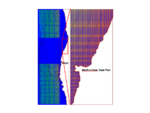
To evaluate the potential impacts of nearshore placement, the CMS and CMS-PTM were applied to simulate sediment transport for combined waves and currents under various ambient conditions and project alternatives. The model results will provide the technical information necessary to evaluate a demonstration site that is economically feasible for the optimum sediment placement location.
CMS-PTM
The CMS calculates water levels, currents and waves through the coupling of a hydrodynamic model, CMS-Flow and a wave spectral model, CMS-Wave. CMS-Flow is driven by time-dependent water surface elevation at the offshore open boundaries, and wind forcing over the surface boundary. Directional wave data for input to CMS-Wave are available from the National Data Buoy Center (NDBC, http://www.ndbc.noaa.gov) and Coastal Data Information Program (CDIP, http://cdip.ucsd.edu). The wave conditions are specified at the seaward boundaries.
CMS-Flow requires three input files and CMS-Wave requires six input files through the SMS. Each of CMS-Flow and CMS-Wave simulations will generate its own output file (Figure 2). The CMS-Flow input and output files are required, while the CMS-Wave output files are optional for setting up a CMS-PTM simulation. After loading the required hydrodynamic and/or wave files, users can follow the steps below to set up the CMS-PTM simulation for the Noyo application.

- Native Sediment Dataset CMS-PTM requires spatially varying native bed sediment data specified as datasets, including the grain size information of d35, d50, and d90 for each cell, in the CMS-Flow grid.
- Select and open the CMS-Flow control file, “flow-exist-Alt2.cmcards” (Figure 2),
- Choose Data | Data Calculator in the CMS-Flow menu,
- Name the first dataset, d35, in the Output data set name and specify a constant value, 0.1 mm in the Calculator,
- Click Compute to generate the dataset,
- Repeat steps iii) and iv) to generate the datasets for d50 and d90 (Figure 3), (for the Noyo simulation, d50=0.2 mm and d90=0.4 mm)
- Click Done to exit Data Calculator,
- Highlight the datasets, d35, d50, and d90, right-click, and select Export Datasets (Figure 4),
- Select XMDF file in the File Type, check All time steps in the Time Steps, and click the Filename to save the file “NativeSediments.h5” in the present working folder.
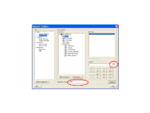
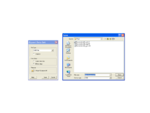
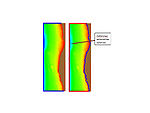
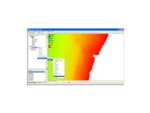
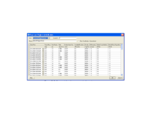
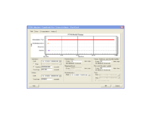
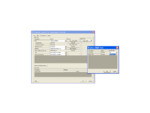
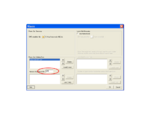


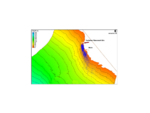
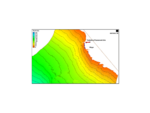
- Land-water Interface Boundary Strings CMS-PTM requires specifications of both open and closed boundaries. Open boundaries are specified in CMS-Flow so closed boundaries need to be added for CMS-PTM (future versions of SMS will automatically generate the closed boundaries). The steps to perform this task are described as follows:
- Choose Cellstring | Generate Along Boundary (this step will generate redundant boundary strings overlapped with existing strings along open boundaries) (Figure 5),
- Choose the Select Cellstring tool and select the Land boundary along the open boundary,
- Right click and choose Delete (Figure 5),
- Repeat steps ii) and iii) to delete other Land boundary cellstrings overlapped with existing open boundaries if more than one open boundaries exist in CMS-Flow,
- Save the project.
- Sediment Sources Particles can be released from different source options. In CMS-PTM, sediment sources can be specified as points, lines, or areas. For the Noyo application, an area source was designated to represent the nearshore placement of dredged materials from a barge. The steps for creating the source file in SMS are:
- Switch to the Map Module,
- Right click the default coverage and choose Type | Models | PTM after generating the rectangular area for the sediment release (Figure 6),
- Choose the Select Feature Polygon icon and click on the area source,
- Right-click the polygon, select Attributes, and the Feature Object Attributes will pop up,
- Select the Horizontal Polygon Source in the Type (Figure 7),
- Specify Date/Time for the particle release, Parcel Mass (kg), released mass Rate (kg/m2/s), and Median Grain Size (mm) of released particles (Figure 7),
- Save the area source specification as a map file.
- CMS-PTM Setup After the hydrodynamic data, native sediment data, source file, and boundary cellstrings are generated, users can follow steps below to specify the CMS-PTM parameters and set up the CMS-PTM simulation.
- Switch to Particle Module,
- Choose PTM | New Simulation,
- Choose PTM | Model Control.
- Simulation time (Figure 8)
- Specify the starting time of the completed CMS-Flow simulation in the Hydrodynamics,
- Specify the starting and ending times of a CMS-PTM run in the Simulation,
- Specify the time step for the CMS-PTM simulation and the output time interval in the Particle Output,
- Specify how often to update the sediment parameters and the hydrodynamic variables.
The starting time of CMS-Wave and the time step for the wave forcing update need to be specified if waves are included in the simulation and selected in the Files page.
- Links to hydrodynamic and sediment data (Figure 9)
- Click Select paths under the XMDF Path and set Alt2/Datasets/Depth for the Depth Path,
- Select the CMS solution file, “flow-exist-alt2_sol.h5”, in the working folder for the Hydrodynamics,
- Set Simulation/Current_Velocity for the Velocity, and Simulation/Water_Elevation for the Water surface elevation,
- Select default coverage in the Sediment source and name part.source in Select filename,
- Select create when model is run in the Neighbor and name part.neighbors in Select filename,
- Include Waves and breaking by selecting CMS-Wave and click options to obtain wave input for CMS-PTM (Figure 10),
- Browse the working folder and to link the wave simulation file, wave-exist-Alt2.sim, under the Parent Grid Geometry | CMS simulation file,
- Link the wave input file, wave-exist-Alt2.wav, under the Parent Grid Solution Data,
- Specify the Number of Spectra in file,
- Click OK to complete the specifications of the page.
Because the wave simulation is included in CMS-PTM, it is necessary to return to the previous (Time) page to specify the Start time and the Time Step under the Waves (Figure 8).
- Computation parameters and output
Most of the options in the Computations page are default for this Noyo application except that the 3D mode is selected (Figure 11). In the Output page (Figure 12), Print default keywords is selected in the File Output, and Source and State are selected in the Particle Output.
CMS-PTM Results
As described in the previous sections for the Noyo application, CMS-PTM was designed to investigate the fate and transport of dredged materials under combined influence of waves and currents from proposed placement sites. The placement site, a rectangular area of 86,600 yd2, is located about 4 miles north of Noyo Harbor near MacKerricher State Park. The CMS-PTM simulation is for August 1 – 30, 2008. In this application, clay materials were released at a level of 1 m above the ocean bottom at a rate of twice daily for 12 days. Each release lasted 10 minutes to mimic the barge placement operation. Figures 13 and 14 show the snapshot of calculated clay particle distributions at the end of the release (day 12) and the end of simulation (day 30), respectively. The simulation shows clay particles either follow the waves propagating towards shore or move southward driven by the northerly wind in this summer period. A good portion of the fine sediments can move passing Noyo Bay to the model’s south boundary and some out of the model domain through the simulation. At the end of simulation, about 65% of released clay particles are considered “dead”, which are either permanently buried at the sea bed or moved out of the model domain.
Additional Information
This wiki technical note was prepared and funded under the Coastal Inlet Research Program (CIRP) and was written by Dr. Honghai Li (Honghai.Li@usace.army.mil, voice: 601-634-2840, fax: 601-634-3080), Dr. Lihwa Lin (Lihwa.Lin@usace.army.mil), and Mitchell E. Brown (Mitchell.E.Brown@usace.army.mil) of the U.S. Army Engineer Research and Development Center (ERDC), Coastal and Hydraulics Laboratory (CHL). The CIRP Program Manager, Dr. Julie D. Rosati (Julie.D.Rosati@usace.army.mil), the assistant Program Manager, Dr. Nicholas C. Kraus, and the Chief of the Coastal Engineering Branch at CHL, Dr. Jeffrey P. Waters reviewed this CHETN. Files for the example may be obtained by contacting the author.
References
- Aquaveo. 2010. SMS: XY Series Files (*.xys). http://www.xmswiki.com/xms/SMS:XY_Series_Files_(*.xys).
- Buttolph, A. M., C. W. Reed, N. C. Kraus, N. Ono, M. Larson, B. Camenen, H. Hanson, T. Wamsley, and A. K. Zundel. 2006. Two-dimensional depth-averaged circulation model CMS-M2D: Version 3.0, Report 2, sediment transport and morphology change. Coastal and Hydraulics Laboratory Technical Report ERDC/CHL-TR-06-7. Vicksburg, MS: U.S. Army Engineer Research and Development Center.
- Demirbilek, Z., K. J. Connell, N. J. MacDonald, and A. K. Zundel. 2008. Particle Tracking Model in the SMS10: IV. Link to Coastal Modeling System. Coastal and Hydraulics Engineering Technical Note ERDC/CHL CHETN-IV-71. Vicksburg, MS: U.S. Army Engineer Research and Development Center. http://chl.erdc.usace.army.mil/chetn.
- Lin, L., Z. Demirbilek, H. Mase, J. Zheng, and F. Yamada. 2008. CMS-Wave: A nearshore spectral wave processes model for coastal inlets and navigation projects. Coastal and Hydraulics Laboratory Technical Report ERDC/CHL-TR-08-13. Vicksburg, MS: U.S. Army Engineer Research and Development Center.
- MacDonald, N. J., M. H. Davies, A. K. Zundel, J. D. Howlett, T. C. Lackey, Z. Demirbilek, and J. Z. Gailani. 2006. PTM: Particle Tracking Model; Report 1: Model theory, implementation, and example applications. Coastal and Hydraulics Laboratory Technical Report ERDC/CHL-TR-06-20. Vicksburg, MS: U.S. Army Engineer Research and Development Center.